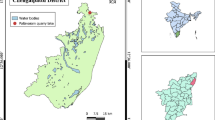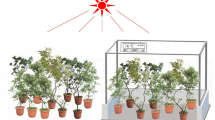Abstract
In northern peatlands with water tables at or near the surface, the Sphagnum moss layer is potentially the only aerobie region where CH4 oxidation can occur. We hypothesized that mosses with varying physiologies would create different conditions for methane-oxidizing bacteria and, in turn, affect rates of CH4 consumption. We measured in-vitro CH4 consumption potential of Sphagnum magellanicum and Sphagnum capillifolium taken from the same habitat and S. magellanicum and Sphagnum majus across habitats to compare and contrast species and environmental effects. In certain cases, S. capillifolium consumed CH4 more rapidly than S. magellanicum taken from identical habitats, although the greatest difference in consumption rates between species was only 29 μg CH4 g−1 dry moss d−1, compared to a maximum difference of 126 and 415 μg CH4 g−1 dry moss d−1 in S. magellanicum and S. majus sampled from different habitats. In most cases, CH4 was consumed most rapidly in the lower, non-photosynthetic portions of the Sphagnum mosses, and consumption potential increased with an increase in the concentration of CH4 in the habitat. We hypothesize that CH4 consumption occurred internally, likely in the hyaline cells, as external surface sterilization did not significantly alter CH4 consumption rates. This work provides evidence that different Sphagnum moss species have variable ability to oxidize CH4, although inter-species differences are small compared to differences across habitats.
Similar content being viewed by others
Literature Cited
Anderson, L. E. 1990. A checklist of Sphagnum in North America north of Mexico. The Bryologist 93:500–501.
Bubier, J., T. R. Moore, and S. Juggins. 1995. Predicting methane emission from bryophyte distribution in northern Canadian peatlands. Ecology 76:677–693.
Bubier, J. L. and T. R. Moore. 1994. An ecological perspective on methane emissions from northern wetlands. Trends in Ecology and Evolution 9:460–464.
Crill, P. M., P. J. Martikainen, H. Nykanen, and J. Silvola. 1994. Temperature and N fertilization effects on methane consumption in a drained peatland soil. Soil Biology and Biochemistry 26: 1331–1339.
Crum, H. A. 1992. A Focus on Peatlands and Peat Mosses. University of Michigan Press, Ann Arbor, MI, USA.
Döbereiner, J. 1980. Methods for Evaluating Biological Nitrogen Fixation. John Wiley, New York, NY, USA.
Frenzel, P. and E. Karofeld. 2000. CH4 emission from a hollow-ridge complex in a raised bog: The role of CH4 production and consumption. Biogeochemistry 51:91–112.
Garneau, M. 2001. Statut trophique des taxons préférentiels et des taxons frequents mais non préférentiels des tourbières naturelles du Québec-Labrador. p. 523–531. In S. Payette and L. Rochefort (ed.) Écologie des tourbières du Québec-Labrador. Les Presses de l’Université Laval. Saint Nicolas, Québec, Canada.
Gorham, E. 1991. Northern peatlands: Role in the carbon balance and probable responses to climatic warming. Ecological Application 1:182–195.
Kravchenko, I. K. 2002. Methane consumption in boreal peat soils treated with various nitrogen compounds. Plant and Soil 242:157–162.
Le Mer, J. and P. Roger. 2001. Production, consumption, emission and consumption of methane by soils: a review. European Journal of Soil Biology 37:25–50.
Moore, T. R. and M. Dalva. 1993. The influence of temperature and water table position on carbon dioxide and methane emissions from laboratory columns of peatland soils. Journal of Soil Science 44:651–664.
Moore, T. R. and M. Dalva. 1997. Methane and carbon dioxide exchange potentials of peat soils in aerobic and anaerobic laboratory incubations. Soil Biology and Biochemistry 29:1157–1164.
Moore, T. R. and N. T. Roulet. 1993. Methane flux: water table relations in northern wetlands. Geophysical Research Letters 20: 587–590.
Moore, T. R., N. T. Roulet, and J. M. Waddington. 1998. Uncertainty in predicting the effect of climatic change on the carbon cycling of Canadian peatlands. Climatic Change 40:229–245.
Segers, R. 1998. Methane production and methane consumption: a review of processes underlying wetland methane fluxes. Biogeochemistry 41:23–51.
Sundh, I., C. Mikkelä, M. Nilsson, and B. H. Svensson. 1995. Potential aerobic methane consumption in a Sphagnum-dominated peatland-controlling factors and relation to methane emission. Soil Biology and Biochemistry 27:829–837.
Svensson, B. H. and I. Sundh. 1992. Factors affecting methane production in peat soils. Suo 43:183–190.
Vasil’eva, L. V., Y. Y. Berestovskaya, and G. A. Zavarzin. 1999. Psychrophilic acidophilic methanotrophic microorganisms from the permafrost Sphagnum. Doklady Biological Sciences 368:523–527.
Waddington, J. M., N. T. Roulet, and R. V. Swanson. 1996. Water table control of CH4 emission enhancement by vascular plants in boreal peatlands. Journal of Geophysical Research 101:22775–22785.
Wahlen, M. 1993. The global methane cycle. Annual Review of Earth and Planetary Science 21:407–426.
Author information
Authors and Affiliations
Rights and permissions
About this article
Cite this article
Basiliko, N., Knowles, R. & Moore, T.R. Roles of moss species and habitat in methane consumption potential in a northern peatland. Wetlands 24, 178–185 (2004). https://doi.org/10.1672/0277-5212(2004)024[0178:ROMSAH]2.0.CO;2
Received:
Revised:
Accepted:
Issue Date:
DOI: https://doi.org/10.1672/0277-5212(2004)024[0178:ROMSAH]2.0.CO;2




